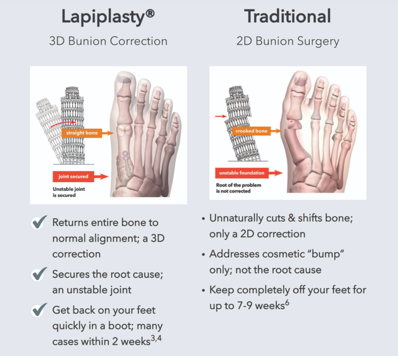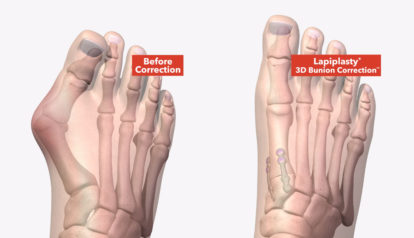Lapiplasty is a surgical procedure that corrects bunions by using titanium plates to secure the unstable joint. This innovative technique addresses the root cause of bunions and allows for quicker post-surgery recovery compared to traditional methods.
Lapiplasty is effective for mild to severe bunions, providing long-lasting results by realigning the metatarsal bone in three dimensions. Patients can expect initial pain and swelling after the procedure, with gradual improvement over several weeks. Compliance with postoperative instructions is crucial to prevent premature implant failure and ensure successful recovery.
Overall, Lapiplasty offers a modern and advanced approach to bunion correction, with promising outcomes for patients seeking a permanent solution to their foot deformity.

Credit: shoalcreekfac.com
Introduction To Lapiplasty
Bunions can be a source of discomfort and frustration for many people, impacting their ability to move comfortably. Lapiplasty is a cutting-edge surgical technique that aims to not only correct the visible bunion deformity but also address its underlying cause. This innovative approach has transformed the way bunions are treated, offering patients a more comprehensive and long-lasting solution.
Defining Lapiplasty
Lapiplasty is an advanced surgical procedure designed to correct the three-dimensional misalignment of the metatarsal bone, which is the root cause of bunions. Unlike traditional bunion surgeries that focus solely on the cosmetic appearance, Lapiplasty aims to provide a more stable and anatomically aligned correction, resulting in a reduced risk of bunion recurrence.
Origins And Development Of The Technique
The Lapiplasty technique was developed as a response to the limitations of traditional bunion surgeries. Its patented technology allows for the correction of the entire bone, rather than just the visible bunion, addressing the underlying cause of the deformity. This approach has revolutionized bunion treatment, offering patients a more comprehensive and enduring solution.

Credit: balancehealth.com
How Lapiplasty Works
Lapiplasty® Procedure utilizes two low-profile titanium plates to permanently secure the corrected bunion foundation, providing stability on multiple planes for quicker post-surgery mobility.
Key Components Of The Procedure
- Utilizes anatomically-shaped titanium plates
- Provides stability on multiple planes
- Allows for early post-surgery weight-bearing
Technological Advances In Lapiplasty
Lapiplasty® technology addresses mild to severe bunions, correcting the entire bone structure for long-lasting results.
Comparative Analysis
Lapiplasty is a cutting-edge procedure that corrects bunions in three dimensions, addressing the root cause for mild to severe cases. By utilizing patented technology, this method secures the entire bone structure, allowing for quicker recovery and long-lasting results.
Comparative AnalysisWhen it comes to treating bunions, there are several options available. One of the newest and most promising options is Lapiplasty. This breakthrough procedure uses patented technology to not only correct the bunion but also its root cause. But how does Lapiplasty compare to traditional bunion surgery?Lapiplasty vs. Traditional Bunion SurgeryTraditional bunion surgery involves cutting the bone and shifting it back into place before using screws or pins to hold it in place. This procedure only corrects the bunion in two dimensions and often results in a lengthy recovery period.Lapiplasty, on the other hand, corrects the bunion in three dimensions and uses low-profile titanium plates to permanently secure the corrected bone. This allows for a more stable foundation and quicker recovery time.Evaluating Efficacy and OutcomesStudies have shown that Lapiplasty has a high success rate in correcting bunions and preventing recurrence. Patients who have undergone Lapiplasty report higher satisfaction rates and fewer complications than those who have undergone traditional bunion surgery.While Lapiplasty may have a slightly higher cost than traditional surgery, the long-term benefits and improved outcomes may make it a worthwhile investment for those suffering from bunions.In conclusion, Lapiplasty is a breakthrough procedure that offers a more effective and efficient solution for those suffering from bunions. Its three-dimensional correction and use of low-profile titanium plates provide a more stable foundation and quicker recovery time compared to traditional bunion surgery.
Credit: www.lapiplasty.com
Patient Experiences
Lapiplasty is a patented procedure designed to correct the root cause of bunions by straightening three dimensions of the metatarsal bone alignment. This innovative technology can address mild, moderate, and severe bunions, offering a more comprehensive solution compared to traditional methods.
Success Stories
Real-life experiences of patients who have undergone Lapiplasty procedures serve as a source of encouragement for those considering treatment. Many individuals have reported significant improvements in their foot health and overall well-being after undergoing the Lapiplasty procedure.
Challenges And Recovery
While the Lapiplasty procedure has garnered positive feedback, it’s important to acknowledge the challenges and recovery process associated with this treatment. Patients may initially experience discomfort and swelling, which gradually diminishes over several weeks. It’s crucial for individuals to adhere to prescribed physical activity instructions to ensure a successful recovery.
Pros And Cons Of Lapiplasty
Lapiplasty is a surgical procedure designed to permanently correct bunions and their root cause. As with any medical intervention, there are both benefits and potential drawbacks to consider when opting for Lapiplasty. It’s important to weigh these factors carefully before deciding to undergo the procedure.
Benefits Highlighted
When considering Lapiplasty, it’s essential to understand the potential benefits that come with this innovative procedure. Here are some of the key advantages:
- Corrects the entire bone and secures the unstable foundation
- Straightens three dimensions of alignment of the metatarsal bone
- Allows patients to walk within days of surgery
- Addresses mild, moderate, and severe bunions
- Treats the root cause of bunion deformity
Potential Drawbacks
While Lapiplasty offers several benefits, there are also potential drawbacks that individuals should be aware of before undergoing the procedure. Here are some of the factors to consider:
- Initial pain and swelling post-surgery
- Minor discomfort may persist for up to a year
- Limitations of the implants used in the procedure
- Possible failure if prescribed physical activity instructions are not followed
Surgical Process Details
The Lapiplasty procedure corrects bunions by securing the unstable foundation with titanium plates, enabling quicker post-surgery mobility. Unlike traditional methods, Lapiplasty addresses the root cause by aligning the metatarsal bone in three dimensions. It offers a breakthrough solution for mild to severe bunion deformities.
Pre-surgical Requirements
Before undergoing Lapiplasty surgery, patients need to go through a thorough evaluation by their doctor. This evaluation will include a physical examination, imaging tests, and a review of the patient’s medical history. Patients will also need to stop taking certain medications, such as blood thinners, for a specific amount of time before the surgery.Step-by-step Procedure
During the Lapiplasty procedure, the surgeon will make a small incision on the side of the foot. They will then use specialized instruments to remove the bony bump on the side of the foot and realign the bones. Two small titanium plates will then be inserted to hold the bones in place while they heal.The Lapiplasty procedure typically takes less than an hour, and patients can usually go home the same day. Recovery time varies, but patients can often start walking within days of the surgery.Pros And Cons
Like any surgical procedure, Lapiplasty has its pros and cons. One of the biggest advantages is that it corrects the root cause of the bunion, rather than just addressing the symptoms. However, there are also potential risks and complications, such as infection or implant failure.It is essential to discuss the pros and cons of Lapiplasty with your doctor to determine if it is the right choice for you. If you are a candidate for Lapiplasty, it can be an effective way to correct your bunion and get back to your daily activities.Post-operative Care
After undergoing a Lapiplasty procedure, proper post-operative care is crucial for successful recovery and long-term health. Here are the key aspects of post-operative care:
Immediate Post-surgery Care
- Rest and Elevate: Elevate your foot to reduce swelling and follow your surgeon’s instructions for rest.
- Pain Management: Take prescribed pain medication and follow the recommended dosage.
- Dressing Care: Keep the surgical site clean and dry as per your healthcare provider’s guidance.
- Follow-up Appointments: Attend all post-operative appointments for wound checks and monitoring.
Long-term Health And Maintenance
- Physical Therapy: Follow a physical therapy plan to regain strength and mobility.
- Footwear: Wear supportive shoes recommended by your doctor to prevent complications.
- Activity Restrictions: Adhere to any activity restrictions provided by your healthcare provider.
- Healthy Lifestyle: Maintain a balanced diet and stay hydrated to support overall healing.
Future Of Bunion Surgery
As medical technology advances, the future of bunion surgery is constantly evolving. One of the innovative procedures that is shaping the future of bunion surgery is Lapiplasty. This groundbreaking surgical technique not only corrects the visible bump but also addresses the root cause of the bunion, providing a more comprehensive and long-lasting solution.
Innovations On The Horizon
Lapiplasty has opened the door to a new era in bunion surgery. With its patented technology, the procedure aims to correct the misalignment of the metatarsal bone in three dimensions, providing a more thorough and enduring solution compared to traditional bunion surgeries.
One of the key innovations of Lapiplasty is the use of anatomically-shaped titanium plates, which secure the corrected bunion in multiple planes. This advancement not only ensures a more stable and durable correction but also allows patients to resume walking within days of the surgery, significantly reducing the downtime associated with traditional bunion surgeries.
Predictions For Lapiplasty Advancements
The future of Lapiplasty holds promising advancements that aim to further improve the procedure and enhance patient outcomes. As the technology continues to evolve, we can anticipate refinements in the surgical technique, leading to even more precise and effective corrections.
Moreover, ongoing research and development in the field of bunion surgery are likely to result in enhanced materials and tools for Lapiplasty, further optimizing the procedure and minimizing recovery times for patients. These advancements are set to revolutionize the field of bunion surgery, making Lapiplasty an increasingly sought-after and preferred option for individuals seeking long-term relief from bunion deformities.
Frequently Asked Questions
Is Lapiplasty Better Than Bunion Surgery?
Lapiplasty offers a more advanced approach to correcting bunions than traditional bunion surgery.
How Is A Lapiplasty Performed?
The Lapiplasty procedure uses titanium plates to secure the bunion’s unstable foundation, allowing for quicker walking post-surgery. The procedure corrects the entire bone and its root cause, treating mild to severe bunions. It may cause initial pain and swelling, but discomfort usually diminishes within six weeks.
Is Lapiplasty Surgery Painful?
Lapiplasty surgery may cause initial pain and swelling, which lessens over time. Minor discomfort could persist for up to a year post-surgery.
What Are The Downsides Of Lapiplasty?
Lapiplasty downsides include implant limitations and potential failure due to non-compliance with physical activity instructions.
Conclusion
Lapiplasty is a revolutionary procedure that addresses the root cause of bunions. With its patented technology, it corrects the misalignment in three dimensions, providing a faster and more effective solution. Patients can benefit from a quicker recovery and long-term stability, making Lapiplasty a promising option for bunion treatment.


